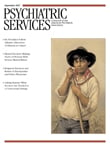Uncertainties in Assessing and Treating Assaultive Patients
To the Editor: In an article in the April issue Quanbeck and colleagues (
1 ) emphasized the heterogeneity of assaultive acts committed by state hospital patients. Such observations stimulate further discussion of the report from Pennsylvania on reducing use of seclusion and restraint (
2 ). Although Quanbeck and colleagues' report did not specifically address seclusion and restraint, it underscores the importance of having a range of available interventions to reduce the adverse consequences of assaultive behaviors.
Although the Pennsylvania group demonstrated the feasibility of reducing seclusion and restraint (
2 ), further clarification of secondary risks appears warranted. The rate of mechanical restraint declined by 60% from 1998 to 2000, from 2.96 to 1.20 episodes per 1,000 patient-days; however, staff injuries with lost work time resulting from patient assaults apparently increased by 30%, from .10 to .13 episodes per 1,000 patient-days. On the basis of the stated census of 2,800, this rate increase represents an increase in the number of injuries from 102 to 133. Whether this apparent increase in injuries was related to reduced seclusion and restraint requires consideration. Added to this figure would be self-injuries, injuries to patients from patient-on-patient assaults, and less severe and unreported assaults on staff (
3,
4 ).
Many rightly state that seclusion and restraint should be a safety measure of last resort, used only when there is an imminent risk of harm and no other safe and effective intervention is available (
5 ). However, assessing imminent risk and the availability of an alternate intervention is fraught with uncertainty and might be considered within the framework of true- and false-positive predictions. True-positive assessments correctly predict that restraints are required to prevent violence; false positives incorrectly predict such need. True negatives correctly predict that restraints are not needed; false negatives incorrectly predict that restraints are not needed. Some have called for bringing restraint rates to zero (
5 ), which would imply that true- and false-positive rates can approach zero. For complete safety, the false-negative rate would also be zero: no violence would occur that is preventable only by restraint. In addition, violence may still occur among those with a true-negative assessment if caregivers make errors in carrying out preventive interventions. The data suggest, however, that even when experts carry out assessments and interventions, it may be unrealistic to completely and safely eliminate restraints in the complex clinical setting of the state hospital.
In state hospitals, dangerousness based on aggression is a common criterion for admission, and as underscored by Quanbeck and colleagues, psychiatric hospitals may retain some high-risk persons who engage in criminal violence. Realistic preventive treatments may not exist for many of these patients.
Assault rates in our state hospitals are too high, and the suffering of assault victims must also be addressed. In our hospital, patients' assaults on staff in recent years have caused facial fractures requiring reconstructive surgery, concussions with neurological sequelae, and a death. Reducing seclusion and restraint may lead to unacceptable risk, as suggested by a near tripling of assault rates in one setting (
3 ) and the apparent increase of 30% in Pennsylvania (
2 ).
Strategies, such as those described by Quanbeck and colleagues, to characterize subtypes of assaultive behaviors may help identify optimal preventive interventions for those at risk of aggression, thereby reducing the rates of true and false positives and false negatives.

